2018-2019年英语沪教版小学六年级上册《Our neighbours》优质课教案
六年级上册英语课件-module 2 unit 4 our neighbours 沪教牛津版
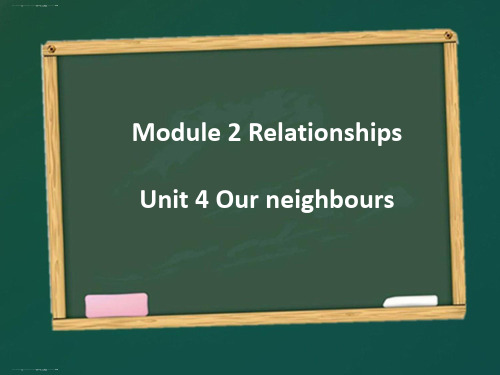
No, I didn’t. I watched TV last weekend.
免费课件公开课免费课件下载免费ppt 下载优 质课件 优秀课 件六年 级上册 英语课 件-mod ule 2 unit 4 our neighbours 沪教牛津版(深圳用)(共13张PPT)
Did you go swimming last weekend?
Did you play basketball last weekend?
免费课件公开课免费课件下载免费ppt 下载优 质课件 优秀课 件六年 级上册 英语课 件-mod ule 2 unit 4 our neighbours 沪教牛津版(深圳用)(共13张PPT)
No, I didn’t. I did my homework last weekend.
Thank you!
免费课件公开课免费课件下载免费ppt 下载优 质课件 优秀课 件六年 级上册 英语课 件-mod ule 2 unit 4 our neighbours 沪教牛津版(深圳用)(共13张PPT)
play football
免费课件公开课免费课件下载免费ppt 下载优 质课件 优秀课 件六年 级上册 英语课 件-mod ule 2 unit 4 our neighbours 沪教牛津版(深圳用)(共13张PPT)
Did you... last weekend?
根据图片提示与你的同伴相互提 问,然后据实回答。
免费课件公开课免费课件下载免费ppt 下载优 质课件 优秀课 件六年 级上册 英语课 件-mod ule 2 unit 4 our neighbours 沪教牛津版(深圳用)(共13张PPT)
go to cinema
免费课件公开课免费课件下载免费ppt 下载优 质课件 优秀课 件六年 级上册 英语课 件-mod ule 2 unit 4 our neighbours 沪教牛津版(深圳用)(共13张PPT)
沪教牛津版小学英语六年级上册Module2《Unit 4 Our neighbours》教学课件PPT

Think and write
Write about a neighbour.
___________is my neighbour. He/ She is _____________(age). He/ She is a/an _____________(job). I often ______________________with him/her. I sometimes _______________with him/her. Last______________, we_______________.
Ms Guo: Did you see them this morning?
Peter: No, I didn’t, but I played with Mike and Nancy last weekend.
Ms Guo: Who are your neighbours, Alice? Alice: The Wus are my neighbours. They have a son. His name is Sam.
一天晚上,猫头鹰又制造噪音。兔子们很生气。“请停止 在晚上制造噪音,”兔子们说,“我们不能睡觉。”但是 猫头鹰不听。
4
One of the rabbits had an idea. “Let’s dig a hole and sleep in it. It’s very quiet underground.”
She sometimes plays chess with her father.
辨析:sometime, some time 与 some times
sometime some time
单词/短语 单词
意思 改天;来日;某个时间
沪教版三年级起点小学六年级英语上册教案Unit 4 Our neighbours_教案2
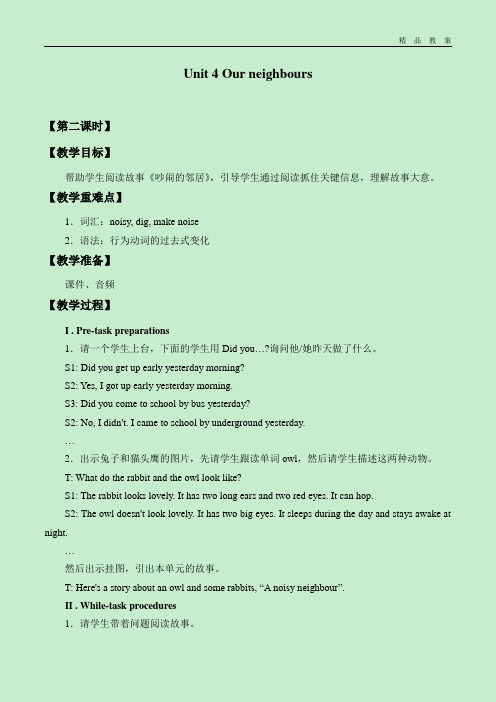
Unit 4 Our neighbours【第二课时】【教学目标】帮助学生阅读故事《吵闹的邻居》,引导学生通过阅读抓住关键信息,理解故事大意。
【教学重难点】1.词汇:noisy, dig, make noise2.语法:行为动词的过去式变化【教学准备】课件、音频【教学过程】I . Pre-task preparations1.请一个学生上台,下面的学生用Did you…?询问他/她昨天做了什么。
S1: Did you get up early yesterday morning?S2: Yes, I got up early yesterday morning.S3: Did you come to school by bus yesterday?S2: No, I didn't. I came to school by underground yesterday.…2.出示兔子和猫头鹰的图片,先请学生跟读单词owl,然后请学生描述这两种动物。
T: What do the rabbit and the owl look like?S1: The rabbit looks lovely. It has two long ears and two red eyes. It can hop.S2: The owl doesn't look lovely. It has two big eyes. It sleeps during the day and stays awake at night.…然后出示挂图,引出本单元的故事。
T: Here's a story about an owl and som e rabbits, “A noisy neighbour”.II . While-task procedures1.请学生带着问题阅读故事。
(1)Where did the rabbits and the owl live? (The rabbits lived under a tree. The owl lived in the tree.)(2)Why was the owl not a good neighbour? (He was a noisy neighbour. He made a lot of noise every night.)(3)What happened one night? (The owl made noise again.)(4)What did the rabbits say to the owl? (“Please stop making noise at night. We can't sleep.”)(5)What idea did the rabbit have? (“Let's dig a hole and sleep in it.”)(6)What did the rabbits do then? (They dug a hole and had a good sleep in the hole.)2.请学生回答问题,同时进行生词的教学。
小学英语沪教牛津版六年级上册Unit 4《Our neighbours》(第1课时)教学PPT

Presentation
What are Ms Guo and Peter talking about?
Ms Guo:Who are your neighbours, Peter? Do you know them? Peter:The Greens are my neighbours, They're from the US. Mr Green is a writer, and Mrs Green is a teacher. They have a son and a daughter, Mike and Nancy. I sometimes meet them in the morning. Ms Guo:Did you see them this morning? Peter:No, I didn't, but I played with Mike and Nancy last weekend. Ms Guo:Who are your neighbours, Alice? Alice:The Wus are my neighbours. They have a son. His name is Sam. Ms Guo:Did you play with Sam last weekend? Alice:Yes, I did. I played chess with him in my home.
(1)He did his homework last night.(改为一般疑问句并作肯定回答) Did he do his homework last night? Yes, he did.
(2)They had a big dinner last week.(改为一般疑问句并作否定回答) Did they have a big dinner last week? No, they didn't.
沪教牛津版英语六年级上Unit 4 Our neighbours
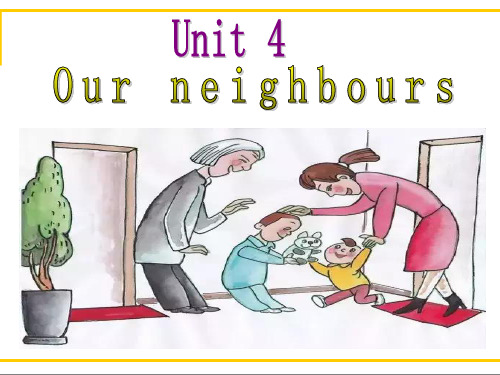
C./
D.the
( D )5.The rabbits
angry.
A.is
B.was
C.did
D.were
三、连一连,组成完整的句子。 1. see,them,you,this,did,morning(?) 2. sleep,many,today,in,rabbits,holes(.) 3. puite,it's,underground,very(.) 4. noisy,the,neighbour,a,owl,is(.) 5. were,they,tired,very(.)
玩耍;游戏
play a game 玩游戏
play with
和……玩
表演;扮演 play the part of 扮演……的角色
图示
词性 动词
含义
短语示例
play football 踢足球
play basketball 打篮球
play ping-pong
踢(打); 打乒乓球 参加比赛 play chess
C.in
D.on
( )4.One of the rabbits had
idea.
A.a
B.an
C./
D.the
( )5.The rallits
angry.
A.is
B.was
C.did
D.were
二、单项选择。
( A )1.My new neighbours are
the US.
A.from
B.at
图示
对应词: daughter 女儿 同音词: sun 太阳
联想记忆
son [sʌn]
儿子(可数名词)
father 爸爸
最新沪教版小学英语六年级上册Module2Unit4Ourneighbours公开课教学设计

最新沪教版小学英语六年级上册Module2Unit4Ourneighbours公开课教学设计Module 2 RelationshipsUnit 4 Our neighbours 教案一、教学目标1. 认知目标:学习掌握新词汇:neighbour,son,daughter,noisy,dig,掌握句型:Who are your neighbours? Did you …? 以及回答:Yes, I did. / No,I didn’t.2. 能力目标:能运用所学句型与同学谈论自己的邻居。
3. 情感目标:让学生通过对课文内容的学习掌握,增强学习的信心,调动学生的学习兴趣。
二、教学重难点1. 重点能运用所学句型与同学谈论自己的邻居。
2. 难点句型:Who are your neighbours? Did you …?以及回答:Yes, I did. / No, I didn’t.三、教学用具多媒体教学设备、单词卡片。
四、教学设计Step 1 warming1. 师生互相问好,教师询问大家是否知道自己家的邻居是谁呢?跟邻居家是否相处的融洽呢?对邻居有多少了解呢?2. 教师向学生们说说自己家的邻居,自己平时如何与邻居相处。
Step 2 Revision and Presentation1. 教师告诉学生我们这节课就要学学如何用英语与同学交流谈论自己的邻居。
2. 教师请学生谈谈自己家的邻居以及相处的如何。
3. 教师出示单词卡片进行新单词教学,带读并配合肢体动作让同学们印象深刻。
4. 教师播放课文内容录音,请同学们认真听一遍,争取做到理解内容。
Step 3 Practice分小组讨论练习,两人一组,相互介绍自己的邻居。
A: What are your neighbours? Do you know them?B: ….A: Did you …?B: Yes, I did. / No, I didn’t.Step 4 Summary教师根据本课时所学内容进行回忆总结,并请同学们谈谈本节课印象最深刻的环节。
牛津沪教版六上英语Unit 4 Our neighbours-教案
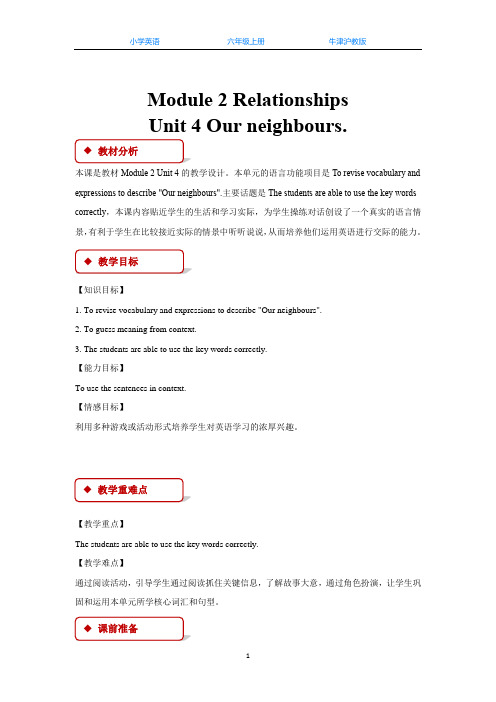
Module 2 RelationshipsUnit 4 Our neighbours.本课是教材Module 2 Unit 4的教学设计。
本单元的语言功能项目是To revise vocabulary and expressions to describe "Our neighbours".主要话题是The students are able to use the key words correctly,本课内容贴近学生的生活和学习实际,为学生操练对话创设了一个真实的语言情景,有利于学生在比较接近实际的情景中听听说说,从而培养他们运用英语进行交际的能力。
【知识目标】1. To revise vocabulary and expressions to describe "Our neighbours".2. To guess meaning from context.3. The students are able to use the key words correctly.【能力目标】To use the sentences in context.【情感目标】利用多种游戏或活动形式培养学生对英语学习的浓厚兴趣。
【教学重点】The students are able to use the key words correctly.【教学难点】通过阅读活动,引导学生通过阅读抓住关键信息,了解故事大意,通过角色扮演,让学生巩固和运用本单元所学核心词汇和句型。
◆教学目标◆教学重难点◆◆课前准备◆◆教材分析Tape recorder, Multimedia◆教学过程Part AListen and sayStep 1:Free talk :T: What do you know about "Our neighbours"?Look at the pictures on P24 and PPT.Talk about "Our neighbours".Encourage them to talk about the topic.To introduce them to the topic.Step 2:ListeningPlay the listening materials,stop when necessary.And then check the answers.To train the students’ ability of catching the information of the listening materi als.Part BLook and learnStep 1:Free talk:Lead them to read and explain the “Our neighbours”.e.g: Who are your neighbours?To review the related knowledge.Make and sayStep 2:Learn the rules in P25.Finish the exercise on P25 and group work to work out the usage method of the “Our neighbours”. Walk around to exam the situation and check the answers for them.List the method of for them.To develop their interest and lead them to the conclude.Part CSay and actLet the students look PPT and act the scene.To make them get familiar with the details of the text and train their ability of saying and reading .Part DSing a songLet the students look PPT and sing a song.Let the students get the general idea of the text.Learn the lettersLearn the letters in P28.List the letters for them.To develop their interest and lead them to the conclude.Homework1.Dictation.e the new words to make sentences on your own or check them in a dictionary.略。
沪教版六年级上册英语Unit 4 Our neighbours讲义(教师版)
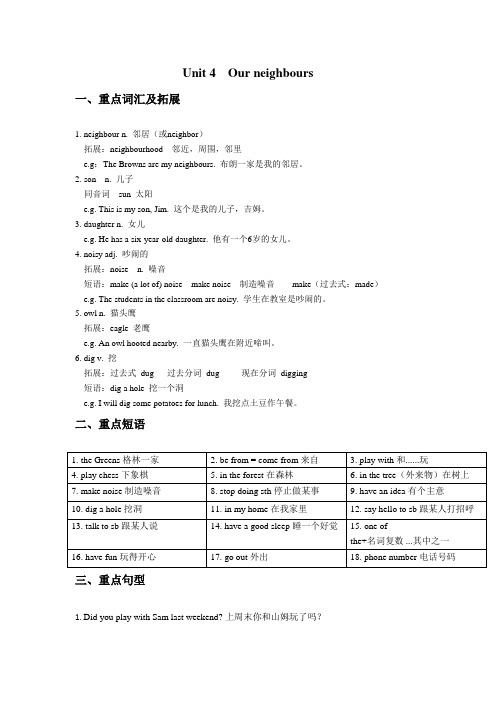
Unit 4 Our neighbours一、重点词汇及拓展1. neighbour n. 邻居(或neighbor)拓展:neighbourhood 邻近,周围,邻里e.g:The Browns are my neighbours. 布朗一家是我的邻居。
2.son n. 儿子同音词sun 太阳e.g. This is my son, Jim. 这个是我的儿子,吉姆。
3. daughter n. 女儿e.g. He has a six-year-old daughter. 他有一个6岁的女儿。
4. noisy adj. 吵闹的拓展:noise n. 噪音短语:make (a lot of) noise make noise 制造噪音make(过去式:made)e.g. The students in the classroom are noisy. 学生在教室是吵闹的。
5. owl n. 猫头鹰拓展:eagle 老鹰e.g. An owl hooted nearby. 一直猫头鹰在附近啼叫。
6. dig v. 挖拓展:过去式dug 过去分词dug 现在分词digging短语:dig a hole 挖一个洞e.g. I will dig some potatoes for lunch. 我挖点土豆作午餐。
二、重点短语三、重点句型1. Did you play with Sam last weekend? 上周末你和山姆玩了吗?肯定回答:Yes, I did.是的,我跟他玩了。
否定回答:No, I didn’t. 不,我没有跟他玩。
2. Who are your/her/his/their neighbours? 谁是你的/她的/他的/他们的邻居们?回答:The +姓氏复数形式are my/her/his/their neighbours.某某一家人是我的/她的/他的/他们的邻居。
3. They are from…. = They come from… 他们来自……提问:Where are you from?/Where do you come from?4. Please stop making noise at night. 请不要在晚上制造噪音。
【优质】小学英语沪教版六年级上册《Ourneighbours》优质公开课教案
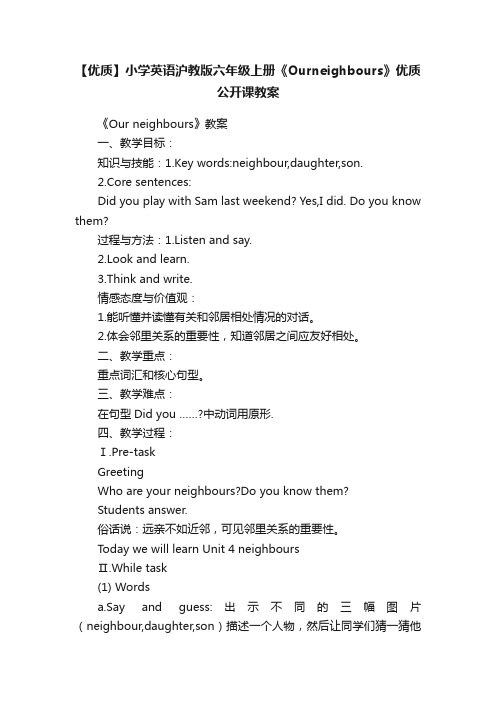
【优质】小学英语沪教版六年级上册《Ourneighbours》优质公开课教案《Our neighbours》教案一、教学目标:知识与技能:1.Key words:neighbour,daughter,son.2.Core sentences:Did you play with Sam last weekend? Yes,I did. Do you know them?过程与方法:1.Listen and say.2.Look and learn.3.Think and write.情感态度与价值观:1.能听懂并读懂有关和邻居相处情况的对话。
2.体会邻里关系的重要性,知道邻居之间应友好相处。
二、教学重点:重点词汇和核心句型。
三、教学难点:在句型Did you ……?中动词用原形.四、教学过程:Ⅰ.Pre-taskGreetingWho are your neighbours?Do you know them?Students answer.俗话说:远亲不如近邻,可见邻里关系的重要性。
Today we will learn Unit 4 neighboursⅡ.While task(1) Wordsa.Say and guess:出示不同的三幅图片(neighbour,daughter,son)描述一个人物,然后让同学们猜一猜他们之间的关系。
b.Read the words after the media.c.Read it more.d.Choose and say:出示图片,让学生选出一张作简单介绍。
(2)Texta.Listen and answer:听课文录音,回答有关对话内容的问题:Who′s Peter′s neighbour?。
上海教育版英语六年级上册Unit4《Ourneighbours》word教案
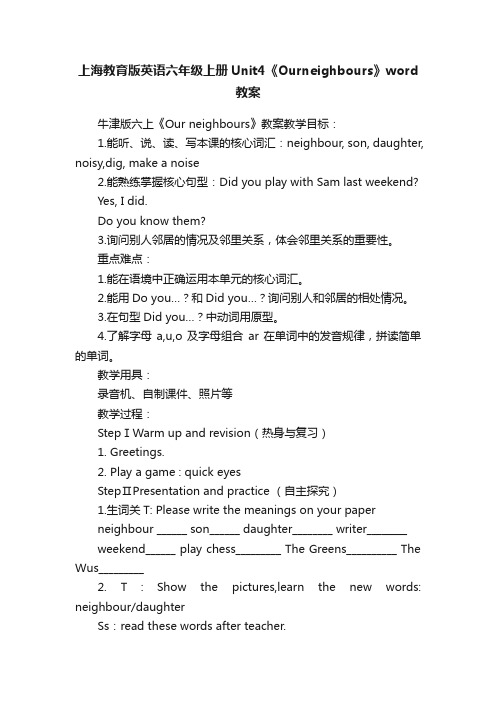
上海教育版英语六年级上册Unit4《Ourneighbours》word教案牛津版六上《Our neighbours》教案教学目标:1.能听、说、读、写本课的核心词汇:neighbour, son, daughter, noisy,dig, make a noise2.能熟练掌握核心句型:Did you play with Sam last weekend?Yes, I did.Do you know them?3.询问别人邻居的情况及邻里关系,体会邻里关系的重要性。
重点难点:1.能在语境中正确运用本单元的核心词汇。
2.能用Do you…?和Did you…?询问别人和邻居的相处情况。
3.在句型Did you…?中动词用原型。
4.了解字母a,u,o及字母组合ar在单词中的发音规律,拼读简单的单词。
教学用具:录音机、自制课件、照片等教学过程:StepⅠWarm up and revision(热身与复习)1. Greetings.2. Play a game : quick eyesStepⅡPresentation and practice (自主探究)1.生词关T: Please write the meanings on your paperneighbour ______ son______ daughter________ writer________weekend______ play chess_________ The Greens__________ The Wus_________2. T:Show the pictures,learn the new words: neighbour/daughterSs:read these words after teacher.3. Work in groups to read the new words. Recite the new words, then recite in groups。
- 1、下载文档前请自行甄别文档内容的完整性,平台不提供额外的编辑、内容补充、找答案等附加服务。
- 2、"仅部分预览"的文档,不可在线预览部分如存在完整性等问题,可反馈申请退款(可完整预览的文档不适用该条件!)。
- 3、如文档侵犯您的权益,请联系客服反馈,我们会尽快为您处理(人工客服工作时间:9:00-18:30)。
《Our neighbours》教案
一、教学目标:
知识与技能:1.Key words:neighbour,daughter,son.
2.Core sentences:
Did you play with Sam last weekend? Yes,I did. Do you know them?
过程与方法:1.Listen and say.
2.Look and learn.
3.Think and write.
情感态度与价值观:
1.能听懂并读懂有关和邻居相处情况的对话。
2.体会邻里关系的重要性,知道邻居之间应友好相处。
二、教学重点:
重点词汇和核心句型。
三、教学难点:
在句型Did you ……?中动词用原形.
四、教学过程:
Ⅰ.Pre-task
Greeting
Who are your neighbours?Do you know them?
Students answer.
俗话说:远亲不如近邻,可见邻里关系的重要性。
Today we will learn Unit 4 neighbours
Ⅱ.While task
(1) Words
a.Say and guess:出示不同的三幅图片(neighbour,daughter,son)描述一个人物,然后让同学们猜一猜他们之间的关系。
b.Read the words after the media.
c.Read it more.
d.Choose and say:出示图片,让学生选出一张作简单介绍。
(2)Text
a.Listen and answer:听课文录音,回答有关对话内容的问题:Who′s Peter′s neighbour?
Did Peter see his neighbours this morning?
Who′s Alice′s neighbour?
Did Alice play with Sam last weekend?
b.Listen again and answer the questions?
c.Translate the sentences by studenfs one by one.Teacher give them a help.
d.Read the textafter the media.
e.Read in pairs
f.Read them again and play roles.
Ⅲ.Post task
a.Make a pratise with the sentences:
“Did you ……?”句型询问他昨天或上个星期是否做了某事。
b.Write about a neighbour.
_____is my neighbour.
He/She is _____(age).He/She is a/an
_____(job).
I often ______with him/her.
Last ____,we ________________.
六、板书设计:
Unit 4 Our neighbours
neighbour daughter s on
——Did you play with Sam last weekend?
——Yes,I did.。
